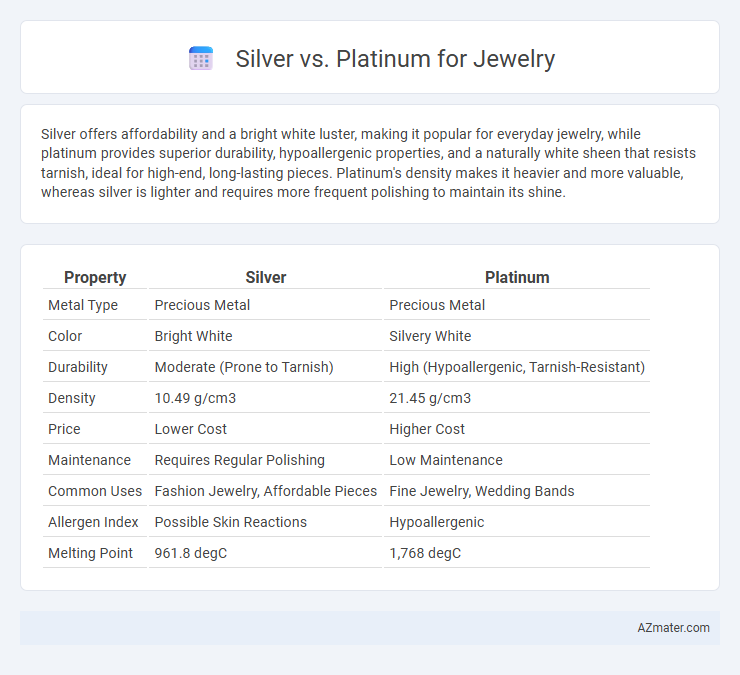Silver offers affordability and a bright white luster, making it popular for everyday jewelry, while platinum provides superior durability, hypoallergenic properties, and a naturally white sheen that resists tarnish, ideal for high-end, long-lasting pieces. Platinum's density makes it heavier and more valuable, whereas silver is lighter and requires more frequent polishing to maintain its shine.
Table of Comparison
| Property | Silver | Platinum |
|---|---|---|
| Metal Type | Precious Metal | Precious Metal |
| Color | Bright White | Silvery White |
| Durability | Moderate (Prone to Tarnish) | High (Hypoallergenic, Tarnish-Resistant) |
| Density | 10.49 g/cm3 | 21.45 g/cm3 |
| Price | Lower Cost | Higher Cost |
| Maintenance | Requires Regular Polishing | Low Maintenance |
| Common Uses | Fashion Jewelry, Affordable Pieces | Fine Jewelry, Wedding Bands |
| Allergen Index | Possible Skin Reactions | Hypoallergenic |
| Melting Point | 961.8 degC | 1,768 degC |
Introduction: Silver vs Platinum
Silver is a popular choice for affordable, stylish jewelry known for its bright white luster and versatility, while platinum stands out as a premium metal prized for its durability, rarity, and naturally white sheen that does not tarnish. Silver jewelry often requires regular polishing to maintain its shine, whereas platinum retains its brilliance over time with minimal maintenance. The distinct physical properties and price points of silver and platinum influence their suitability for different types of jewelry designs and wear occasions.
Historical Significance in Jewelry
Silver has been used in jewelry since ancient times, renowned for its affordability and bright luster, symbolizing wealth and status in many early civilizations such as the Egyptians and Romans. Platinum, introduced into jewelry in the 19th century, became a symbol of exclusivity and durability, favored by European royalty and the Art Deco movement for its strength and resistance to tarnish. The historical significance of silver lies in its widespread cultural and functional use, while platinum represents technological advancement and modern luxury in jewelry design.
Appearance and Luster Comparison
Silver jewelry features a bright white sheen with a natural shine that can develop a warm patina over time, enhancing its vintage appeal. Platinum offers a distinctive silvery-white luster that retains its brightness and resists tarnishing, maintaining a consistent radiant finish. The superior density and reflective quality of platinum provide a more substantial, enduring polish compared to silver's softer, more malleable surface.
Durability and Strength Differences
Platinum is significantly more durable and stronger than silver, making it ideal for everyday wear and heavy-duty jewelry pieces. Silver, while attractive and more affordable, is softer and prone to scratches, tarnishing, and bending over time. Platinum's dense molecular structure provides superior resistance to wear, maintaining its shape and shine longer compared to silver alloys.
Hypoallergenic Properties
Platinum offers superior hypoallergenic properties compared to silver, as it is a naturally pure metal that rarely causes allergic reactions. Silver often contains alloy metals like nickel, which can trigger skin sensitivities and irritations in those prone to allergies. Choosing platinum jewelry is ideal for individuals with sensitive skin seeking durable, hypoallergenic options.
Maintenance and Tarnish Resistance
Platinum jewelry offers superior tarnish resistance and requires minimal maintenance compared to silver, which is prone to oxidation and needs regular polishing to maintain its shine. Silver tends to develop a dark patina over time, necessitating frequent cleaning with specialized cloths or solutions. Platinum's dense, non-reactive properties allow it to retain its luster longer, making it ideal for those seeking low-maintenance luxury pieces.
Cost and Investment Value
Silver jewelry offers an affordable entry point with prices significantly lower than platinum, making it accessible for everyday wear. Platinum commands a much higher market value due to its rarity, durability, and hypoallergenic properties, often seen as a long-term investment with potential appreciation. While silver may tarnish and require maintenance, platinum retains its luster and strength, providing superior investment value over time.
Popular Uses in Jewelry Types
Silver is widely favored for crafting intricate rings, bracelets, and earrings due to its affordability and bright luster, making it popular in everyday and fashion jewelry. Platinum is prized in high-end wedding bands, engagement rings, and luxury timepieces for its durability, hypoallergenic properties, and natural white sheen that resists tarnish. Both metals serve distinct roles, with silver dominating in trendy, casual styles and platinum excelling in premium, lasting pieces.
Customization and Design Flexibility
Platinum offers superior customization and design flexibility for jewelry due to its density and malleability, allowing intricate details and secure settings for gemstones. Silver, while more affordable, is softer and prone to scratching, which can limit delicate design complexity and longevity in custom pieces. Jewelers often prefer platinum for bespoke designs that require durability and fine craftsmanship.
Choosing the Right Metal for Your Needs
Silver offers affordability and a bright, shiny finish, best suited for everyday wear and those on a budget, but it is prone to tarnishing and requires regular maintenance. Platinum, a denser and more durable metal, provides exceptional strength, hypoallergenic properties, and a naturally white luster that doesn't fade, making it ideal for fine jewelry and pieces meant to last a lifetime. Choosing between silver and platinum depends on factors like budget, durability needs, skin sensitivity, and the type of jewelry intended for frequent or occasional use.

Infographic: Silver vs Platinum for Jewelry
 azmater.com
azmater.com